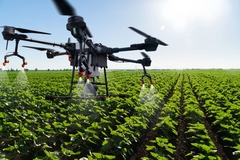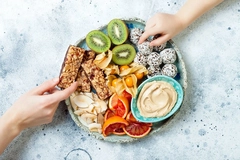Impossible Foods: Shaping the future of the planet with vegetarian burgers
30 Apr 2018 --- As conversations about diet, the future of the planet and health continue to dominate media and the food industry, Impossible Foods says it is on a mission to make delicious, nutritious meat and dairy products directly from plants – with a much smaller environmental footprint than meat from animals. The company uses modern science and cutting-edge technology to create wholesome food, restore natural ecosystems and sustainably feed a growing global population.

 In 2011, the Impossible Burger was born. It made its debut at Chef David Chang's Momofuku Nishi in Manhattan. The Impossible Burger is the only plant-based burger to win a 2017 Tasty Award and a 2018 Fabi Award from the National Restaurant Association.
In 2011, the Impossible Burger was born. It made its debut at Chef David Chang's Momofuku Nishi in Manhattan. The Impossible Burger is the only plant-based burger to win a 2017 Tasty Award and a 2018 Fabi Award from the National Restaurant Association.Last month, Impossible Foods made its international debut in Hong Kong after the success of the company's burger, The Impossible Burger is served in more than 1,400 outlets in the US – from award-winning restaurants to the fast-food chain, White Castle. The vast majority of these restaurants serve the Impossible Burger on a bun with traditional condiments and sides.
The Impossible Burger is made from pure ingredients, including water, wheat protein, potato protein and coconut oil. One special ingredient – heme – contributes to the characteristic taste of meat and is the essential catalyst for all the other flavors when meat is cooked. Heme is a fundamental molecular building block of life, one of nature's most ubiquitous molecules. Although it's found in all living things and in virtually all the food we eat, it's mainly abundant in animal tissues. Impossible scientists discovered that it's the abundance of heme in animal tissues that makes meat taste like meat.

Communications at Impossible Foods
FoodIngredientsFirst: Why is now a good time for global expansion?
Impossible Foods: Impossible Foods’ mission is to transform the global food system to support the planet and growing human population. Our goal is to replace animals with a food production technology and provide consumers with meat, fish, and dairy foods that are good for both people and the planet. Recently, we launched in our first international market: Hong Kong. We chose Hong Kong, not only because it is an epicenter for cultural and food trends, but also because meat demand is increasingly growing in Asia – and faster than anywhere else on the planet. On the back of this, we hope to see additional international markets on the horizon. In Hong Kong, we are working with world-renowned chefs May Chow of Little Bao and Happy Paradies and Uwe Opocensky of Beef & Liberty.
FoodIngredientsFirst: What have been some of the challenges you have faced before becoming a multimillion-dollar company?
Impossible Foods: In the early R&D stages of testing the Impossible Burger, one of the main challenges was finding the right balance of ingredients. Our many prototypes reflect the “one step forward, two steps back, three steps forward, one step back” process. For example, finding a protein that improves the texture of the burger could create some off flavors, or playing with the fat composition could make the burger more delicious, but give it different cooking properties. Balancing all of these factors and making sure all our ingredient sources are sustainable and scalable was difficult but extremely important.
FoodIngredientsFirst: What is happening regarding vegan/vegetarian foods and trends within this space that you were able to see an opportunity within?
Impossible Foods: We were the first to take a molecular approach to understanding the full experience of eating meat, and are targeting primarily meat-lovers with our products. Impossible Foods spent many years building a proprietary technology platform to understand what makes meat (and other animal products) behave and cook like they do, at the molecular level – and how to identify those same elements in plants.
FoodIngredientsFirst: What products have you launched and what has the response been so far?
Impossible Foods: Our first product on the market is the Impossible Burger which debuted in 2016. It is currently served at over 1,400 restaurants and chains in the US and Hong Kong, many of which are award-winning restaurants by top chefs and “better burger” chains. Response to date has been great – in a blind taste-test, about half the tasters preferred the Impossible Burger to ground beef from cows, based purely on taste. Consumers particularly like the way the Impossible Burger’s exterior caramelizes and becomes pleasantly crispy on the edges, whether it’s served rare, medium or well done. When consumers were told that the Impossible Burger has no antibiotics, hormones, slaughterhouse contaminants or cholesterol, they preferred it even more.
 FoodIngredientsFirst: Regarding innovation, what are you offering that hasn’t been done before? Are you looking to expand your offerings with new products?
FoodIngredientsFirst: Regarding innovation, what are you offering that hasn’t been done before? Are you looking to expand your offerings with new products?Impossible Foods: Our Impossible Burger is the only plant-based burger that mimics the taste, feel and smell of a beef burger from a cow. Impossible Foods’ was founded to replace animals as food production technology, and our platform will enable us to understand and recreate all animal products – meat, dairy, and fish – using plants. The goal is to produce a full range of meats and dairy products for every cultural region in the world.
FoodIngredientsFirst: What are you seeing a demand for from consumers?
Impossible Foods: Consumers want delicious food that tastes amazing and it’s a bonus if that food doesn’t come with the environmental footprint of meat from animals. We also often hear from consumers about versions of the burger they’d like to see, and the good news there is we are listening and able to adapt the product in various ways. Stay tuned for news on that front.
FoodIngredientsFirst: How have you come up with the recipes? Are there any other products that can mimic blood?
Impossible Foods: The Impossible Burger is made mostly of water, plant proteins, coconut oil, and heme. Heme is a key ingredient of the Impossible Burger which gives the Impossible Burger its unique meaty flavor. It’s a protein molecule that is found in all living things – both plants and animals – and is what makes meat taste and look like meat. So while its heme that makes meat taste like meat, it’s the chefs that cook with Impossible that come up with the innovative recipes that transform the product into savory meatballs, tartare, tacos and baos. The Impossible Burger is the only product that can perform in a chef’s hands just like meat from animals and we continue to be amazed and impressed by the creativity we are seeing.
By Elizabeth Green












